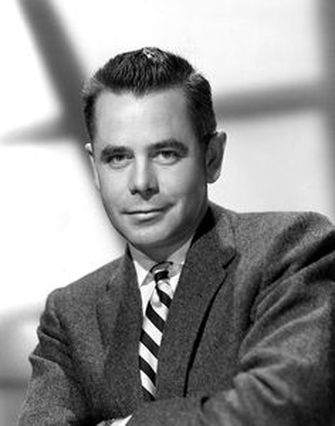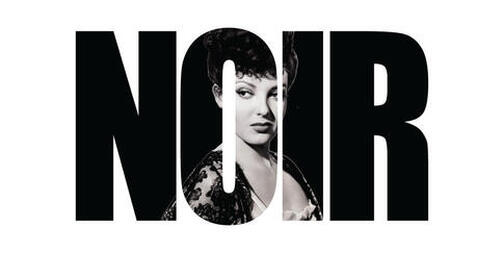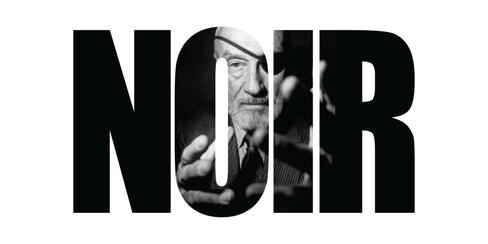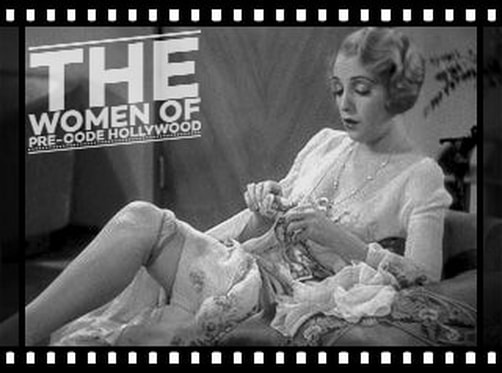GLENN FORD
AND FILM NOIR
Glenn Ford made a significant and lasting contribution to the film noir genre through his versatile performances and his ability to portray both heroic and morally ambiguous characters. With his rugged charm and natural acting style, Ford left an indelible mark on the noir films in which he appeared.
One of Ford's most notable film noir roles came in the 1946 classic "Gilda," directed by Charles Vidor. In this iconic noir drama, Ford played the character Johnny Farrell, a casino owner caught in a love triangle with the seductive and manipulative Gilda, played by Rita Hayworth. Ford's portrayal of Johnny showcased his ability to embody a conflicted and tormented character. He brought a sense of vulnerability and simmering intensity to the role, making Johnny a complex and memorable noir protagonist.
Another noteworthy film in which Ford made an impact was "The Big Heat" (1953), directed by Fritz Lang. In this dark and gritty noir, Ford played the role of Detective Sergeant Dave Bannion, a dedicated cop seeking justice after his wife's suspicious death. Ford's performance captured the character's determination, as he delved into the corrupt underworld and fought against powerful forces. He effectively portrayed Bannion's transformation from a by-the-book detective to a man consumed by revenge, adding depth and intensity to the film.
Furthermore, Ford appeared in other notable noir films such as "The Lady in Question" (1940), "Framed" (1947), and "Human Desire" (1954). In each of these films, Ford brought a sense of authenticity and charisma to his characters, elevating the films with his presence.
Overall, Glenn Ford's contribution to film noir was substantial. His performances in "Gilda," "The Big Heat," and other films showcased his ability to embody complex characters and add depth to the genre. Ford's rugged charm, nuanced acting, and his portrayal of characters torn between desire, loyalty, and darkness left a lasting impact on the noir genre, solidifying his place among the notable actors associated with it.
One of Ford's most notable film noir roles came in the 1946 classic "Gilda," directed by Charles Vidor. In this iconic noir drama, Ford played the character Johnny Farrell, a casino owner caught in a love triangle with the seductive and manipulative Gilda, played by Rita Hayworth. Ford's portrayal of Johnny showcased his ability to embody a conflicted and tormented character. He brought a sense of vulnerability and simmering intensity to the role, making Johnny a complex and memorable noir protagonist.
Another noteworthy film in which Ford made an impact was "The Big Heat" (1953), directed by Fritz Lang. In this dark and gritty noir, Ford played the role of Detective Sergeant Dave Bannion, a dedicated cop seeking justice after his wife's suspicious death. Ford's performance captured the character's determination, as he delved into the corrupt underworld and fought against powerful forces. He effectively portrayed Bannion's transformation from a by-the-book detective to a man consumed by revenge, adding depth and intensity to the film.
Furthermore, Ford appeared in other notable noir films such as "The Lady in Question" (1940), "Framed" (1947), and "Human Desire" (1954). In each of these films, Ford brought a sense of authenticity and charisma to his characters, elevating the films with his presence.
Overall, Glenn Ford's contribution to film noir was substantial. His performances in "Gilda," "The Big Heat," and other films showcased his ability to embody complex characters and add depth to the genre. Ford's rugged charm, nuanced acting, and his portrayal of characters torn between desire, loyalty, and darkness left a lasting impact on the noir genre, solidifying his place among the notable actors associated with it.
AVAILABLE FILMS:
3:10 TO YUMA (1957)
AFFAIR IN TRINIDAD (1952)
BIG HEAT, THE (1953)
CONVICTED (1950)
CONVICTED WOMAN (1940)
DESPERADOES, THE (1943)
DESTROYER (1943)
EXPERIMENT IN TERROR (1962)
FRAMED (1947)
GALLANT JOURNEY (1946)
GILDA (1946)
HEAVEN WITH A BARBED WIRE FENCE (1939)
HUMAN DESIRE (1954)
LADY IN QUESTION, THE (1940)
MR. SOFT TOUCH (1949)
MY SON IS GUILTY (1940)
RANSOM! (1956)
REDHEAD AND THE COWBOY, THE (1950)
SECRET OF CONVICT LAKE, THE (1951)
SHEEPMAN, THE (1958)
STOLEN LIFE, A (1946)
TERROR ON A TRAIN (1953)
TIME FOR KILLING, A (1967)
TORPEDO RUN (1958)
TRIAL (1955)
UNDERCOVER MAN, THE (1949)
AFFAIR IN TRINIDAD (1952)
BIG HEAT, THE (1953)
CONVICTED (1950)
CONVICTED WOMAN (1940)
DESPERADOES, THE (1943)
DESTROYER (1943)
EXPERIMENT IN TERROR (1962)
FRAMED (1947)
GALLANT JOURNEY (1946)
GILDA (1946)
HEAVEN WITH A BARBED WIRE FENCE (1939)
HUMAN DESIRE (1954)
LADY IN QUESTION, THE (1940)
MR. SOFT TOUCH (1949)
MY SON IS GUILTY (1940)
RANSOM! (1956)
REDHEAD AND THE COWBOY, THE (1950)
SECRET OF CONVICT LAKE, THE (1951)
SHEEPMAN, THE (1958)
STOLEN LIFE, A (1946)
TERROR ON A TRAIN (1953)
TIME FOR KILLING, A (1967)
TORPEDO RUN (1958)
TRIAL (1955)
UNDERCOVER MAN, THE (1949)
VIDEO TRIBUTE:
Glenn Ford

Glenn Ford (1916-2006) was a Canadian-born American actor who had a prolific career in film and television spanning over five decades. He appeared in numerous successful films, becoming one of Hollywood's most respected and versatile actors. Ford was known for his naturalistic acting style and his ability to excel in a variety of genres, including dramas, westerns, and film noir.
Gwyllyn Samuel Newton Ford, known as Glenn Ford, was born on May 29, 1916, in Sainte-Christine-d'Auvergne, Quebec, Canada. His family later moved to California, where Ford grew up. He attended Santa Monica High School and developed an early interest in acting.
Ford began his acting career in the late 1930s, initially appearing in small roles in films such as "Heaven with a Barbed Wire Fence" (1939) and "Texas" (1941). He caught the attention of studio executives and signed a contract with Columbia Pictures in 1940, marking the start of his successful association with the studio.
In the 1940s, Ford gained recognition for his performances in films such as "Gilda" (1946), opposite Rita Hayworth, and "The Big Heat" (1953), directed by Fritz Lang. He demonstrated his versatility by taking on diverse roles in films like "3:10 to Yuma" (1957), a western, and "Blackboard Jungle" (1955), a drama tackling social issues.
Ford's talent as an actor earned him critical acclaim and commercial success. He received a Best Actor Academy Award nomination for his performance in the film "Pocketful of Miracles" (1961). Some of his other notable films include "The Desperadoes" (1943), "A Stolen Life" (1946), "Teahouse of the August Moon" (1956), and "Superman" (1978), where he portrayed Clark Kent's adoptive father, Jonathan Kent.
In addition to his film work, Ford appeared on television, starring in the series "Cade's County" (1971-1972) and making guest appearances on shows like "The Twilight Zone" and "Columbo."
Ford's career continued into the 1980s and 1990s, with roles in films such as "Midway" (1976), "The Visitor" (1979), and "Day of the Evil Gun" (1968). He eventually retired from acting in the late 1990s, with his final on-screen appearance in the film "Final Verdict" (1991).
Glenn Ford was married four times and had one son. He was known for his professionalism, integrity, and dedication to his craft. In recognition of his contributions to the film industry, Ford was honored with a star on the Hollywood Walk of Fame.
Glenn Ford passed away on August 30, 2006, in Beverly Hills, California, at the age of 90. His legacy lives on through his extensive body of work, and he is remembered as a talented and respected actor who made significant contributions to the world of cinema.
Gwyllyn Samuel Newton Ford, known as Glenn Ford, was born on May 29, 1916, in Sainte-Christine-d'Auvergne, Quebec, Canada. His family later moved to California, where Ford grew up. He attended Santa Monica High School and developed an early interest in acting.
Ford began his acting career in the late 1930s, initially appearing in small roles in films such as "Heaven with a Barbed Wire Fence" (1939) and "Texas" (1941). He caught the attention of studio executives and signed a contract with Columbia Pictures in 1940, marking the start of his successful association with the studio.
In the 1940s, Ford gained recognition for his performances in films such as "Gilda" (1946), opposite Rita Hayworth, and "The Big Heat" (1953), directed by Fritz Lang. He demonstrated his versatility by taking on diverse roles in films like "3:10 to Yuma" (1957), a western, and "Blackboard Jungle" (1955), a drama tackling social issues.
Ford's talent as an actor earned him critical acclaim and commercial success. He received a Best Actor Academy Award nomination for his performance in the film "Pocketful of Miracles" (1961). Some of his other notable films include "The Desperadoes" (1943), "A Stolen Life" (1946), "Teahouse of the August Moon" (1956), and "Superman" (1978), where he portrayed Clark Kent's adoptive father, Jonathan Kent.
In addition to his film work, Ford appeared on television, starring in the series "Cade's County" (1971-1972) and making guest appearances on shows like "The Twilight Zone" and "Columbo."
Ford's career continued into the 1980s and 1990s, with roles in films such as "Midway" (1976), "The Visitor" (1979), and "Day of the Evil Gun" (1968). He eventually retired from acting in the late 1990s, with his final on-screen appearance in the film "Final Verdict" (1991).
Glenn Ford was married four times and had one son. He was known for his professionalism, integrity, and dedication to his craft. In recognition of his contributions to the film industry, Ford was honored with a star on the Hollywood Walk of Fame.
Glenn Ford passed away on August 30, 2006, in Beverly Hills, California, at the age of 90. His legacy lives on through his extensive body of work, and he is remembered as a talented and respected actor who made significant contributions to the world of cinema.
Quotes:
"When I'm on camera, I have to do things pretty much the way I do things in everyday life. It gives the audience someone real to identify with."
"Ronald Reagan was a true friend and an American Patriot. We are proud of him and his service to the country. We need men like him today."
"Some actors count their lines as soon as they receive a script. I'm the opposite. I try to see how many lines I can whittle down...You can say just as much in 4 as you can in 14."
"Hell, no actor is going to tell Frank Capra how to make a picture. He has forgotten more about movie-making than most directors ever know."
- Glenn Ford
Trivia:
Often during his career he insisted on being shot looking to camera left--he had been kicked in the right side of his jaw by a horse and insisted the left side of his face was his only filmable side.
He has appeared in five films with Rita Hayworth: Affair in Trinidad (1952), The Lady in Question (1940), The Loves of Carmen (1948), The Money Trap (1965) and Gilda (1946).
Credited with being one of the fastest "guns" in Hollywood westerns; able to draw and fire in 0.4 seconds, he was faster than James Arness (Matt Dillon of Gunsmoke (1955)) and John Wayne. However, Peter Breck (Nick Barkley of The Big Valley (1965)) has been credited by Wild Western Magazine as being able to draw and fire in .16 seconds.
Went on a jungle mission with a Special Forces team during the Vietnam War.
After having been a member of the Coast Guard Auxiliary for a year, he joined the Marine Corps during WWII in December of 1942, and subsequently met first wife, tap-dancing extraordinaire Eleanor Powell, at a war-bond cavalcade. They married in 1943.
According to a biography of Sam Peckinpah, Ford was considered for Robert Ryan's role in The Wild Bunch (1969).
He had intended to portray Hondo Lane in Hondo (1953), but backed out when John Farrow was chosen to direct. Ford and Farrow did not got along while making Plunder of the Sun (1953), causing Ford to lose interest in the role. The role was subsequently portrayed by John Wayne.
He has appeared in five films that have been selected for the National Film Registry by the Library of Congress as being "culturally, historically or aesthetically" significant: Gilda (1946), The Big Heat (1953), Blackboard Jungle (1955), 3:10 to Yuma (1957) and Superman (1978).
He has appeared in five films with Rita Hayworth: Affair in Trinidad (1952), The Lady in Question (1940), The Loves of Carmen (1948), The Money Trap (1965) and Gilda (1946).
Credited with being one of the fastest "guns" in Hollywood westerns; able to draw and fire in 0.4 seconds, he was faster than James Arness (Matt Dillon of Gunsmoke (1955)) and John Wayne. However, Peter Breck (Nick Barkley of The Big Valley (1965)) has been credited by Wild Western Magazine as being able to draw and fire in .16 seconds.
Went on a jungle mission with a Special Forces team during the Vietnam War.
After having been a member of the Coast Guard Auxiliary for a year, he joined the Marine Corps during WWII in December of 1942, and subsequently met first wife, tap-dancing extraordinaire Eleanor Powell, at a war-bond cavalcade. They married in 1943.
According to a biography of Sam Peckinpah, Ford was considered for Robert Ryan's role in The Wild Bunch (1969).
He had intended to portray Hondo Lane in Hondo (1953), but backed out when John Farrow was chosen to direct. Ford and Farrow did not got along while making Plunder of the Sun (1953), causing Ford to lose interest in the role. The role was subsequently portrayed by John Wayne.
He has appeared in five films that have been selected for the National Film Registry by the Library of Congress as being "culturally, historically or aesthetically" significant: Gilda (1946), The Big Heat (1953), Blackboard Jungle (1955), 3:10 to Yuma (1957) and Superman (1978).




